Google Discover can help you get in front of your target audience for free. And send thousands of visitors to your website every month.
Read this guide to learn how to optimize for Google Discover and increase the chances of having your content displayed in users’ Discover feeds.
What Is Google Discover?
Google Discover is a feed that allows users to discover content related to their interests. It displays content based on users’ activity across Google’s services.
Google Discover is available in the Google app and the mobile version of Google Chrome.
It looks like this:
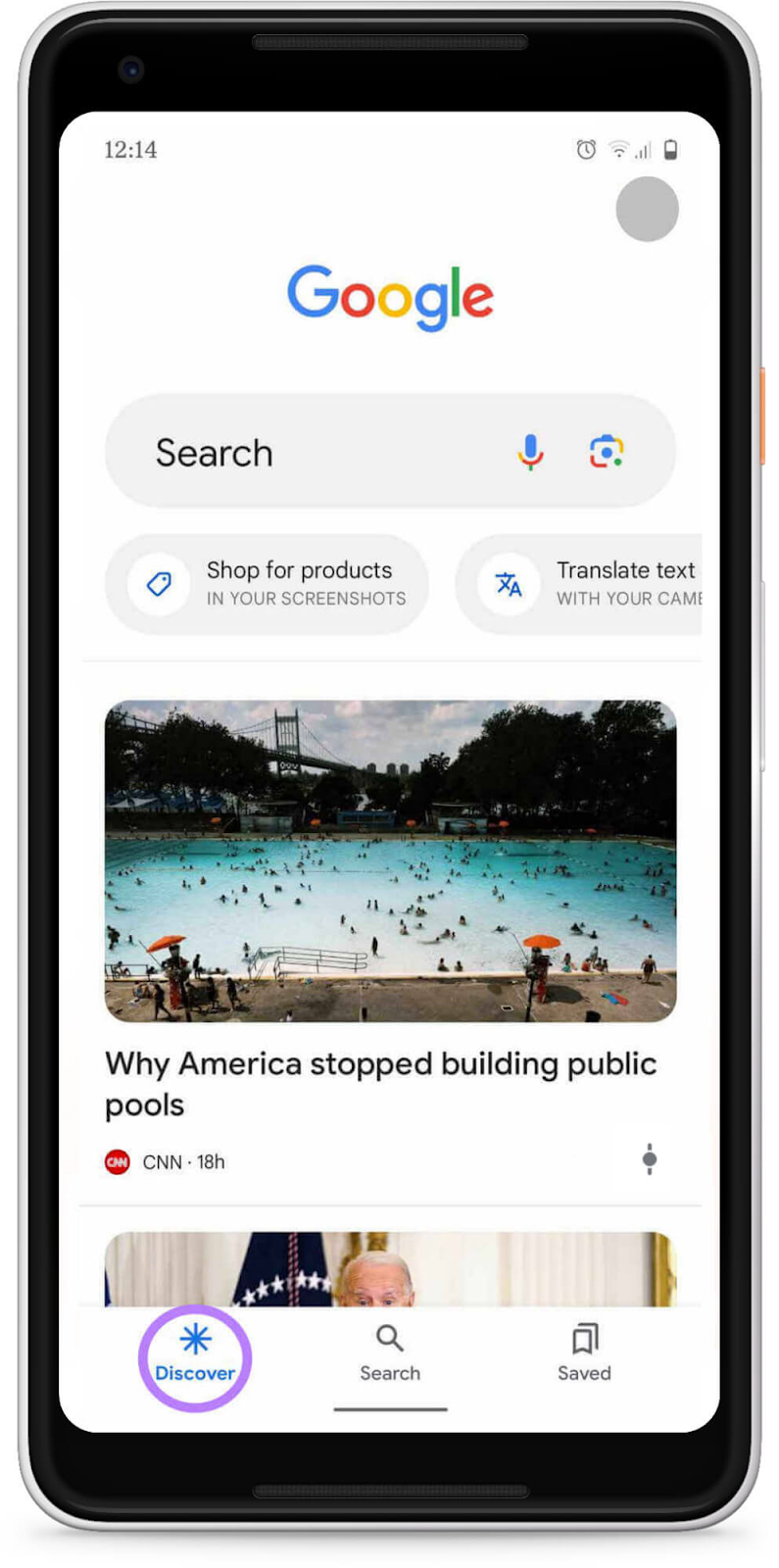
Should You Optimize for Google Discover?
Yes—you probably should. Here’s why:
- Increase visibility: Google Discover allows you to get in front of your target audience for free. It’s a great way to introduce your brand and content to new potential customers.
- Drive traffic: While over time, users don’t just scroll through their Google Discover feed; they also click through and visit the recommended websites. Some publishers, such as Condé Nast, drive as much as 20% of their U.S. website traffic from Google Discover.
- Get more return visits: Because Google Discover gives users the option to follow publications, it can be a great source of return visits for your website.
How Does Google Discover Work?
To be eligible to appear in Google Discover, content needs to be indexed by Google and meet Google Discover’s content policies.
Note that just because a specific piece of content is eligible doesn’t necessarily mean that it will get displayed in Google Discover.
The Google Discover feed looks very similar to a social media feed. Like the ones on Facebook and Instagram.
Users can scroll through the feed, click on content that interests them, and then get taken to the website that hosts the content.
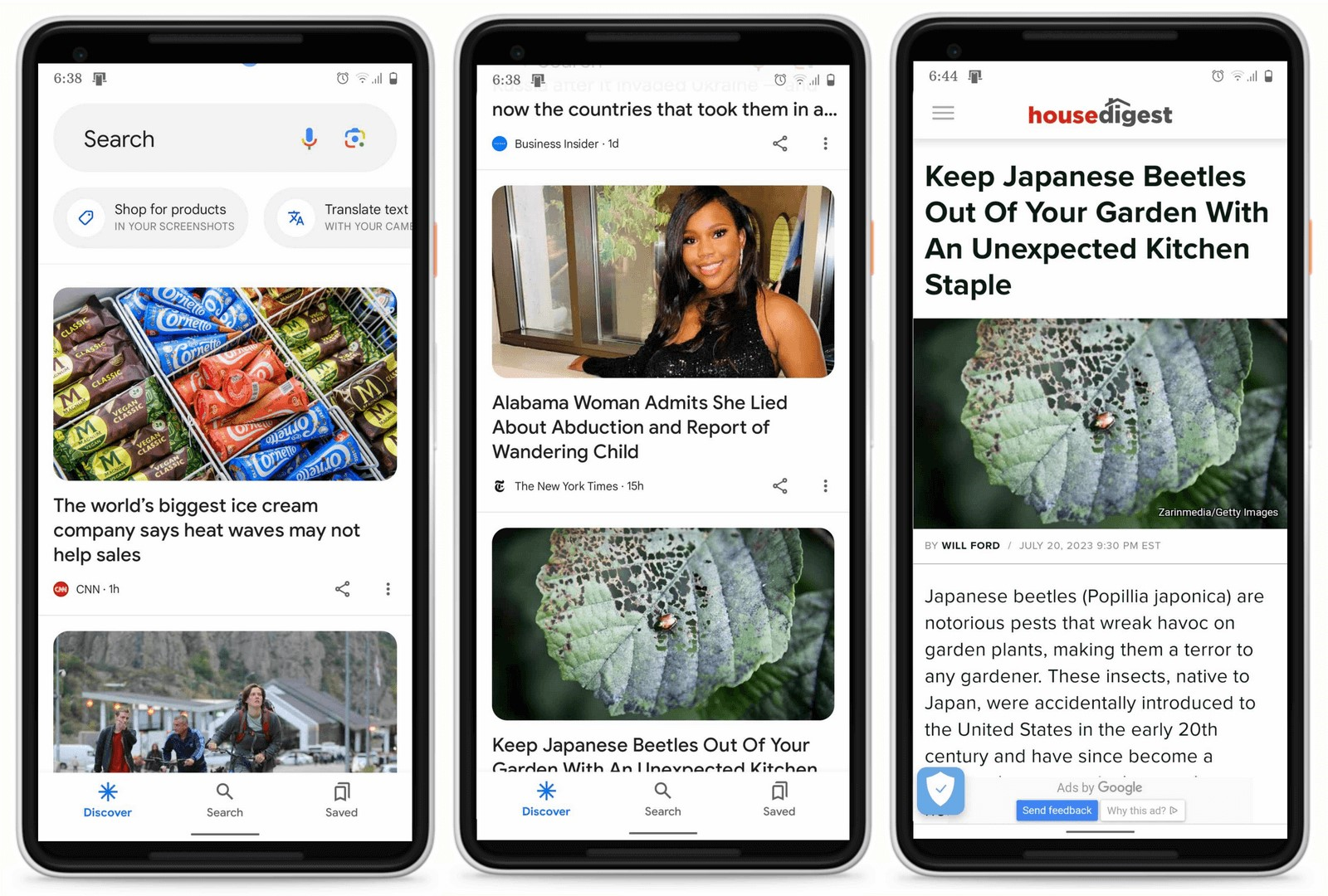
Google Discover vs. Google News
Google Discover and Google News are two completely different Google products.
Google News is a news aggregator that mostly focuses on current events and recently published content.
Google Discover, on the other hand, aims to offer users content that’s relevant to their interests, regardless of the publication date.
How Your Google Discover Feed Is Generated
Google states that it uses the following data to generate a user’s Discover feed:
- Web and app activity
- Location history
- Location settings
- Topics you follow
Discover’s recommendations are refined as you keep using Discover and Google learns more about you.
For example, if you develop an interest in motorcycles and keep visiting related websites and content, Google Discover will start showing you more motorcycle-related content.
This means that the traffic businesses get from Discover may change over time. Based on changing interests, different content types produced, and Google updates.
So as you optimize your content, you might see increases or decreases in Discover-generated traffic.
The Different Types of Google Discover Content
Google Discover predominantly displays these four types of content:
- Article links: Links to online articles from various publishers. Each article link is displayed as a card that includes a headline and a thumbnail image.
- Web Stories: This format combines video, images, and audio—similar to an Instagram story. You can learn more about Web Stories here.
- YouTube videos and Shorts: A user’s Google Discover feed can also include YouTube videos and Shorts, which are recommended based on the user’s YouTube history.
- Discovery Ads: Ads created with Google Discovery campaigns also appear in the feed periodically.
Following Websites and Topics
Google Discover includes a “Follow” feature that allows users to follow a website and get its latest updates displayed in the “Following” tab in Google Chrome.
The feature uses a website’s RSS or Atom feed to display the latest updates. If a website doesn’t have either of these feeds, Google will generate one automatically.
Apart from websites, you can also follow specific topics to have content related to those topics displayed in your feed more often.
Users can control how frequently they want to see content related to a specific topic by clicking on a card’s toggle icon and selecting “More” or “Less.”
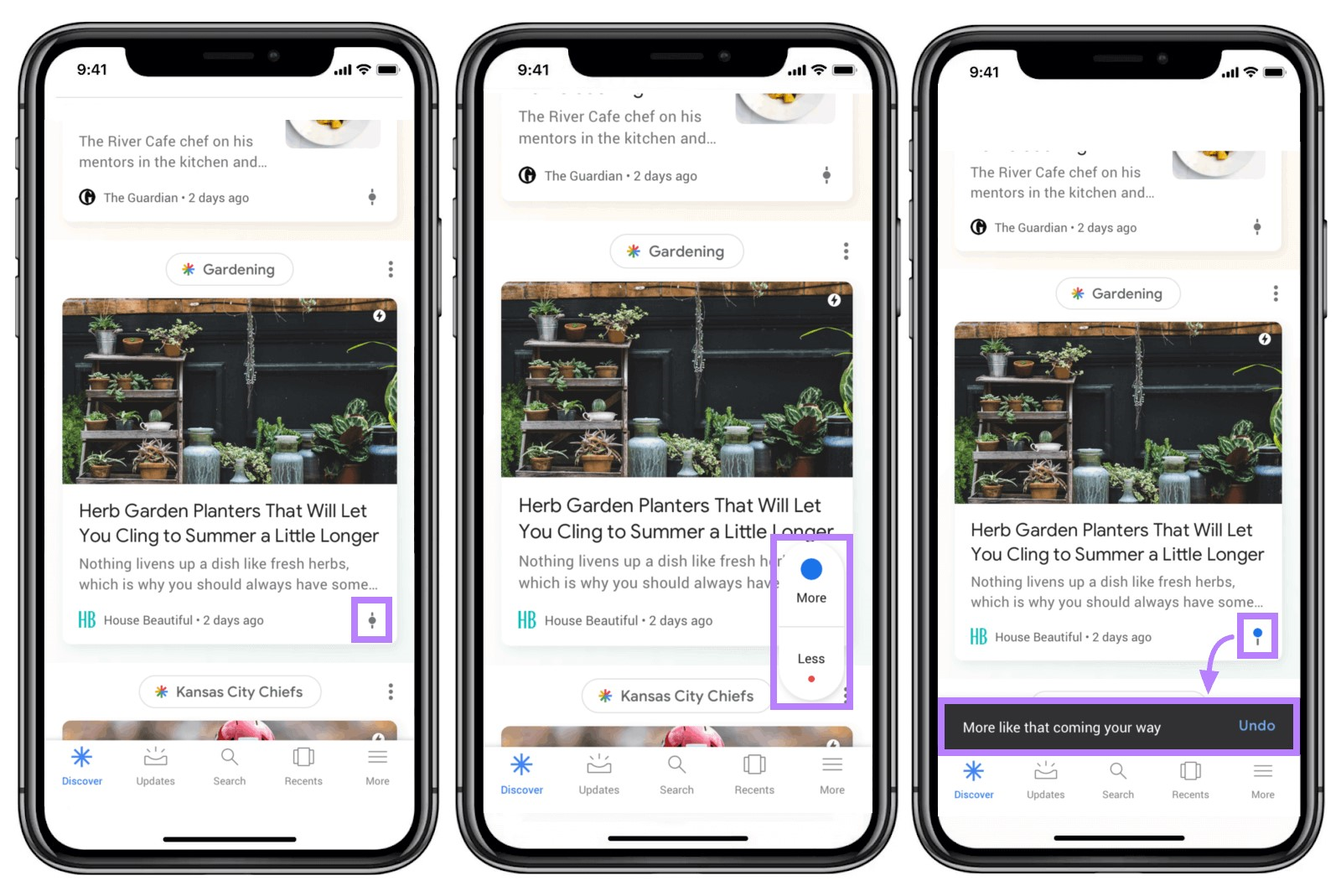
5 Ways to Optimize for Google Discover
Now, let’s look at how to get on Google Discover. Follow these five tips to optimize your content for Discover:
1. Create High-Quality Content
The first step to getting better results with Google Discover is simply to make sure you create high-quality content.
According to Google, this means creating content that:
- Covers a particular topic comprehensively
- Provides original information based on analysis or research
- Doesn’t simply copy or retell information from other sources
Follow these tips to create high-quality content:
Start with In-Depth Research
Before you can create a great piece of content, you need to be knowledgeable about the topic you’re covering.
Here are a few things you can do to develop expertise on any given topic:
- Read through existing web content on the topic (e.g., blog posts, articles, and guides)
- Research what other people are saying about the topic on platforms like Reddit and Quora
- Find videos and podcasts discussing the topic
- Interview a few subject matter experts to get insights you might not be able to uncover otherwise
Be Comprehensive
Aim to cover the topic comprehensively and try to include all the information people might want to know about the topic.
Semrush’s Keyword Magic Tool can be of great help here. Because it can show you questions people are asking about your topic.
Here’s how to use it:
In the Keyword Magic Tool, type in the basic subject you’re targeting and click the green “Search” button.

The tool will then show you a list of results. From here, click the “Questions” tab.
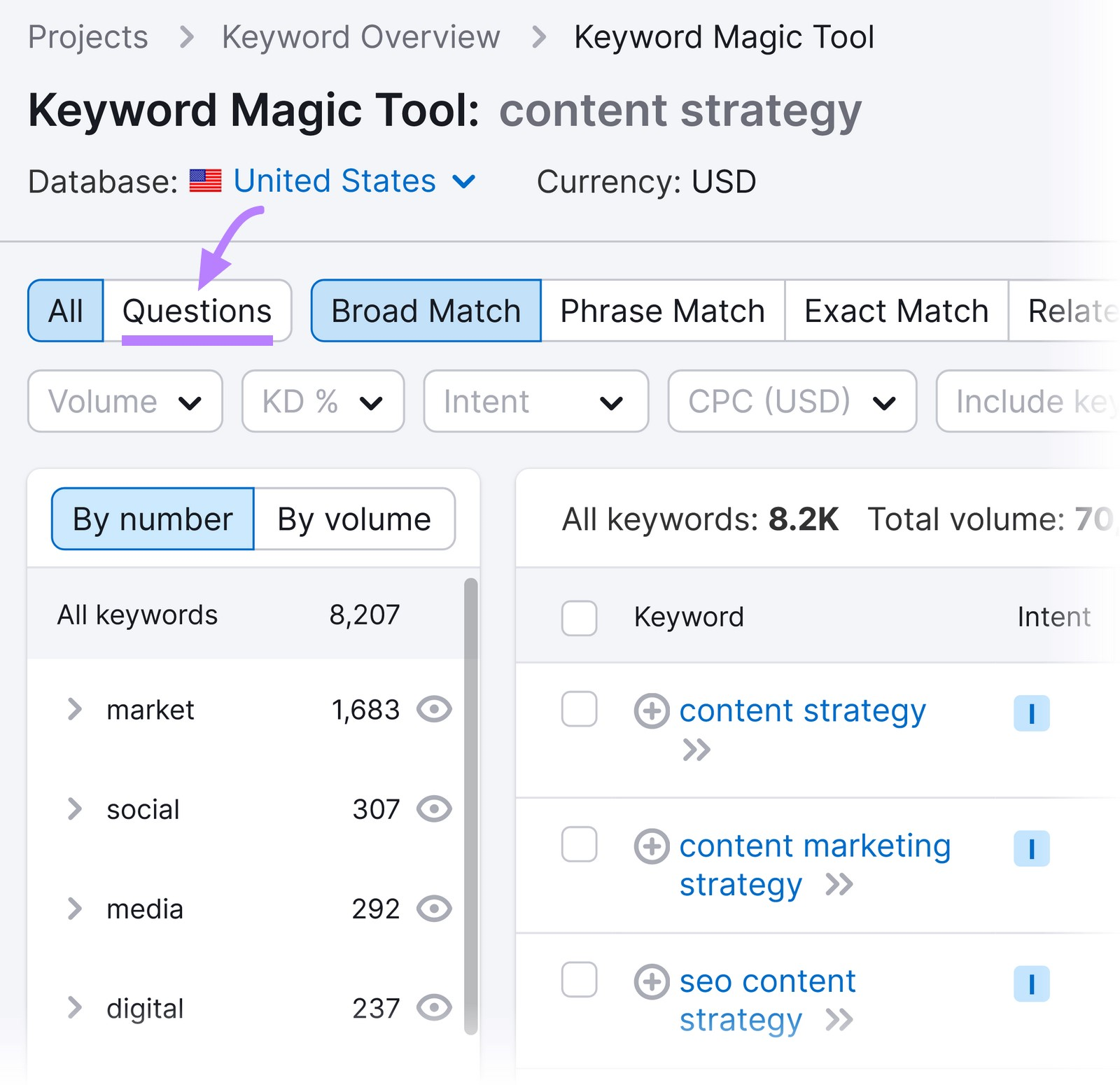
Here, you can see all the different queries people are searching for that include your main keyword. Use these as inspiration for questions to answer within your content.
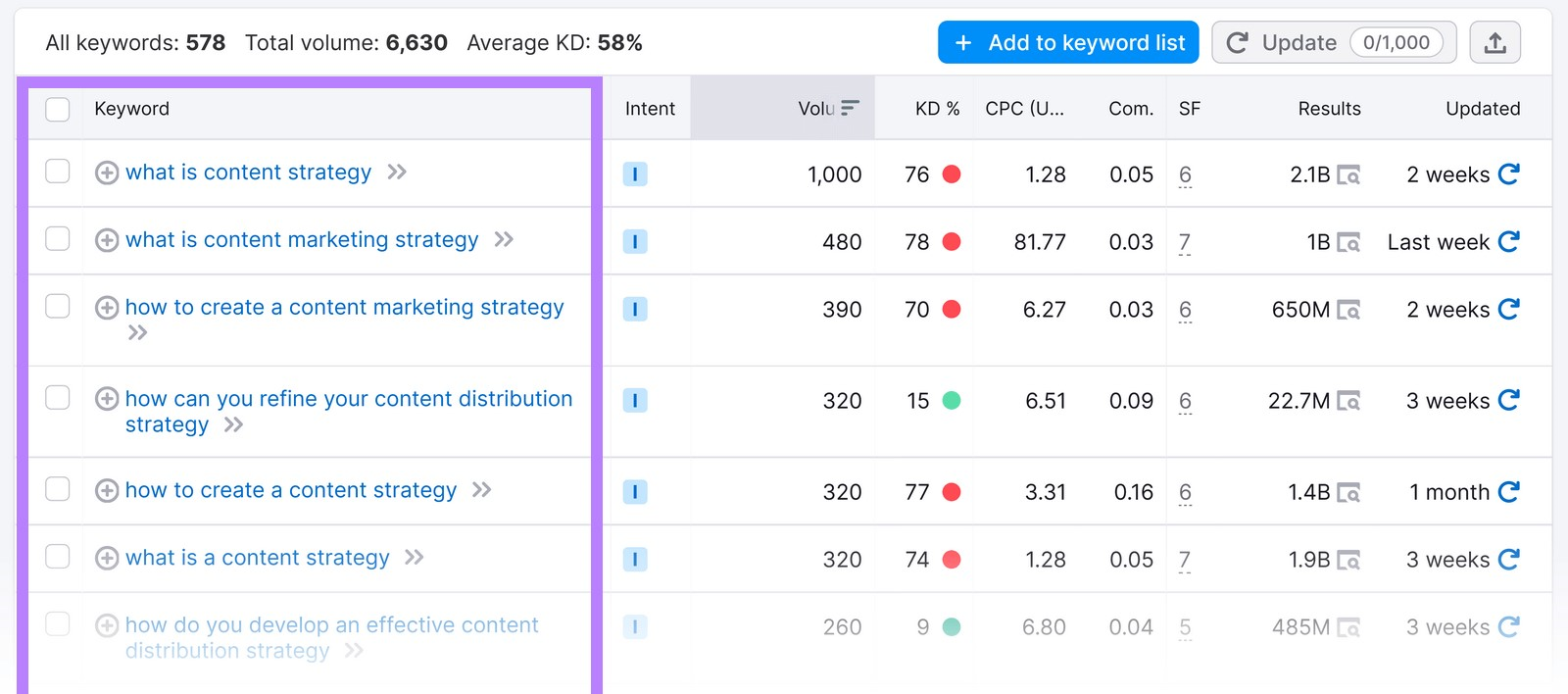
Include Data
Referring to studies or statistics within your content can make your content more credible and back up the claims you make.
Ideally, you’ll have data you’ve collected on your own (e.g., by performing a survey) to use within your content.
Alternatively, you can use secondary data from studies other people or companies have done. If you decide to use secondary data, however, make sure to cite your sources and include a link to the original research.
2. Optimize Your Titles
Once you’ve made sure your content is top-notch, make sure your titles are optimized for Google Discover.
Follow these best practices to create titles that are optimized for Google Discover:
- Show the value: Your title should let users know what value they would get from consuming your content (e.g., “How to Make Your First $100 Online”)
- Spark curiosity: Try to spark curiosity with your title to make users more likely to click (e.g., “Eggs vs. Oatmeal: Which Breakfast Option is Healthier for You”)
- Try to include numbers: Numbers tend to grab people’s attention, so try to include them in your title if possible (e.g., “22% of Americans Have No Emergency Savings”)
- Avoid clickbait: Google Discover guidelines forbid misleading content, so avoid using clickbait titles
Here are a few effective title formats you can try:
- Lists (e.g., “10 Ways to Make Side Income This Year”)
- What and why titles (e.g., “Why Is My Dog Smiling?”)
- How-tos (e.g., “How to Fix Your Posture”)
- Devil’s advocate titles (e.g., “Why Eggs Are Actually Horrible for You”)
- Versus titles (e.g., “Free Weights vs. Machines: Which is Better for Building Muscle?”)
3. Use Compelling, High-Quality Images
Google recommends that websites use large, high-quality images to generate more visits from Google Discover.
According to Google’s guidelines, large images need to be 1200px wide or more and enabled by using the “max-image-preview:large” setting.
It’s important that the images you use are relevant to the content itself. Avoid using eye-grabbing images that have nothing to do with what your content is about.
Also, spend some time choosing a compelling thumbnail image for your Google Discover content.
The thumbnail makes up a large portion of a content card in Google Discover. Because of this, it’s going to have an impact on the click-through rate your content gets in Discover.
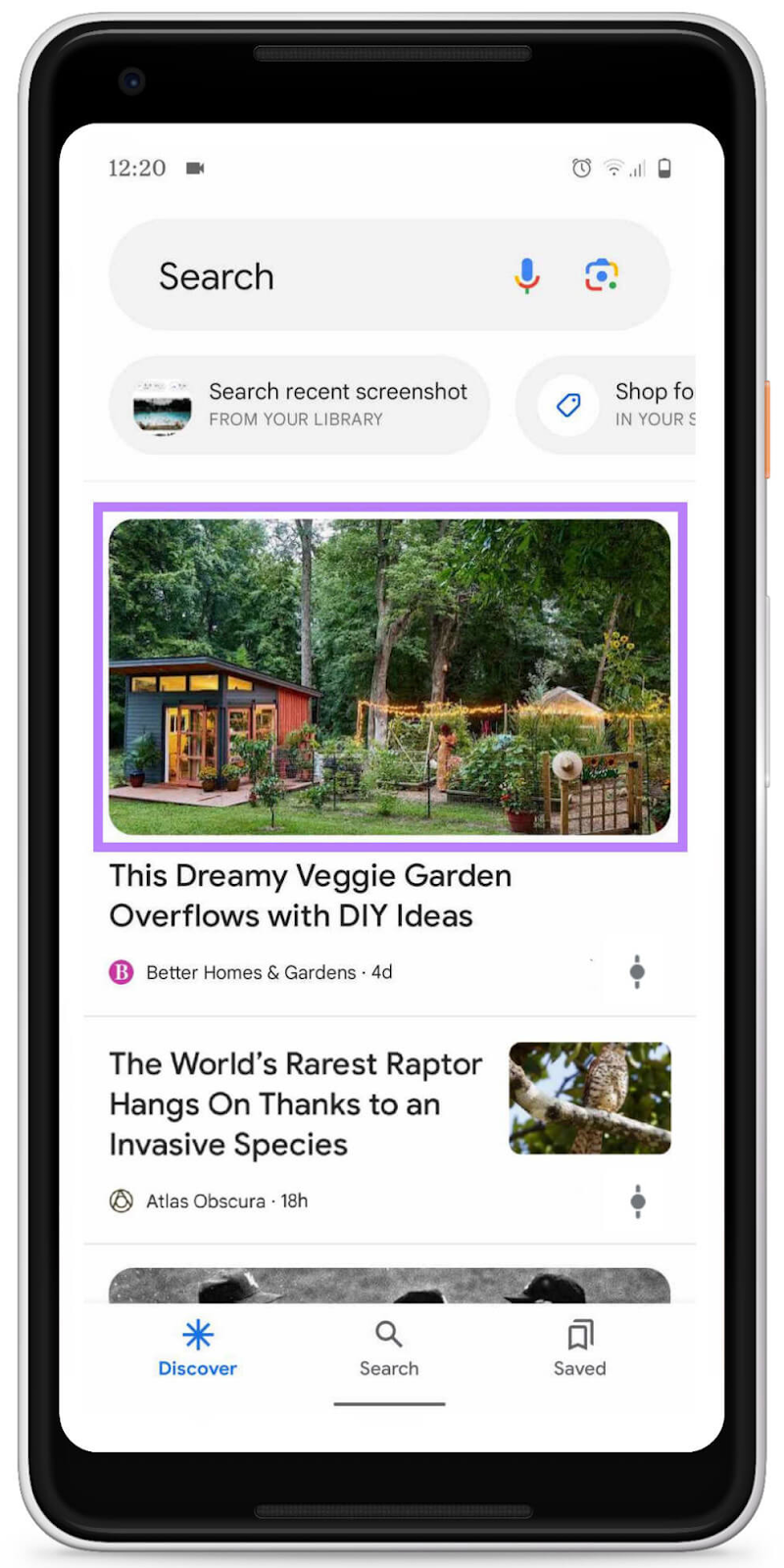
Make sure not to use your website logo for the thumbnail image since this is against Google’s guidelines. Also, try not to use an image with a white background to avoid having it blend in with Google Discover’s user interface (which is also mostly white).
4. Improve E-E-A-T
Google Discover’s documentation states that it uses a lot of the same signals and guidelines as Google Search when determining whether a piece of content is helpful. For Search, one of the most important considerations is E-E-A-T, which stands for:
- Experience – Does the author have experience with the topic?
- Expertise – Is the author an expert on the topic?
- Authoritativeness – Is the author (or the website) an authority on the topic?
- Trustworthiness – Is the author (or website) trustworthy?
If you demonstrate E-E-A-T within your content, you’re showing that it’s worthwhile to display your content to users. Here’s how to improve E-E-A-T:
Include Personal Experiences
Whenever possible, talk about your personal experiences with the topic.
For example, if you’re writing an article about dog training, make sure to mention your experience with training your own dog and what you learned from it.
Showcase Your Expertise
One of the best ways to showcase expertise is by writing a detailed author bio that explains why you’re an expert on the topic you’re writing about.
A few things you can consider including in your bio:
- Your job title
- Years of experience
- A short summary of why you’re an expert on the topic
- Any media coverage you’ve received
- Awards, degrees, or titles
Here’s an example bio from yours truly:

Become an Authority on the Subject
There are two main ways you can signal authority:
- Develop topical authority
- Gain backlinks from other authoritative websites
To develop topical authority, you’ll want your website to cover your chosen area of expertise as comprehensively as possible.
For example, if you’d like your website to be seen as an authority on fitness, you should cover as many fitness-related topics as possible.
Apart from covering your area of expertise comprehensively, you can also show authority by gaining backlinks from other authoritative websites in your industry. Either organically or by using various link building tactics.
Show You’re Trustworthy
When rating a page’s trustworthiness, Google’s Quality Raters look at:
- The author: Who is the author? Do they have the authority to write about the topic?
- The content: Is the content factually accurate? Does it cite trustworthy sources?
- The website: Does the website look trustworthy? Does it feature deceptive web design or distracting ads?
The above is detailed in Google’s Search Quality Rater Guidelines.
To help raters see your page as trustworthy, make sure to:
- Clearly state who the author of the content is and why they’re relevant to talk about the topic.
- Make sure your content is factually accurate and genuinely helpful. Back up your claims by linking to trustworthy sources.
- Avoid using pop-ups and other distracting website elements on the page.
5. Optimize Your Content for Mobile
Because Google Discover is only available for mobile devices, it’s crucial that your content and website are optimized for mobile browsing.
Follow these best practices to optimize your website for mobile devices:
Improve Page Load Speed
Nowadays, people expect websites to load fast. They don’t want to wait for more than a second or two for a website to load.
In fact, a user is 32% more likely to leave a website if the page load time increases from one to three seconds.
Mobile users are especially impatient. Because they might be browsing the web on the go, during a work break, or while on lunch, they often don’t have the time or patience for slow-loading websites.
Here are a few things you can do to speed up your website:
- Compress images: High-definition images can significantly slow down a website. Take advantage of image compression tools to reduce the size of your website images. Alternatively, use a file format like WebP to ensure small file sizes with minimal impact on image quality.
- Minify code: Remove unnecessary HTML, CSS, and JavaScript from your website through minification. Use an online solution like Minify or a plugin like WP Rocket.
- Use a CDN: Improve page speed by using a content delivery network (CDN) such as Cloudflare or Akamai to deliver website content to users from servers that are physically closest to them.
If you’d like to get more customized advice for improving your page speed, audit your website using Semrush’s Site Audit tool. The tool will check your website for more than 140 issues.
Here’s how to use it:
On the Site Audit Tool page, enter your domain and hit the “Start Audit” button.

Next, you can customize the audit settings if you’d like. In most cases, you can keep the default settings and click the “Start Audit” button.
The tool will then audit your website and generate a report outlining all the discovered issues.
In the “Overview” tab, click the “View details” button in the “Site Performance” section.
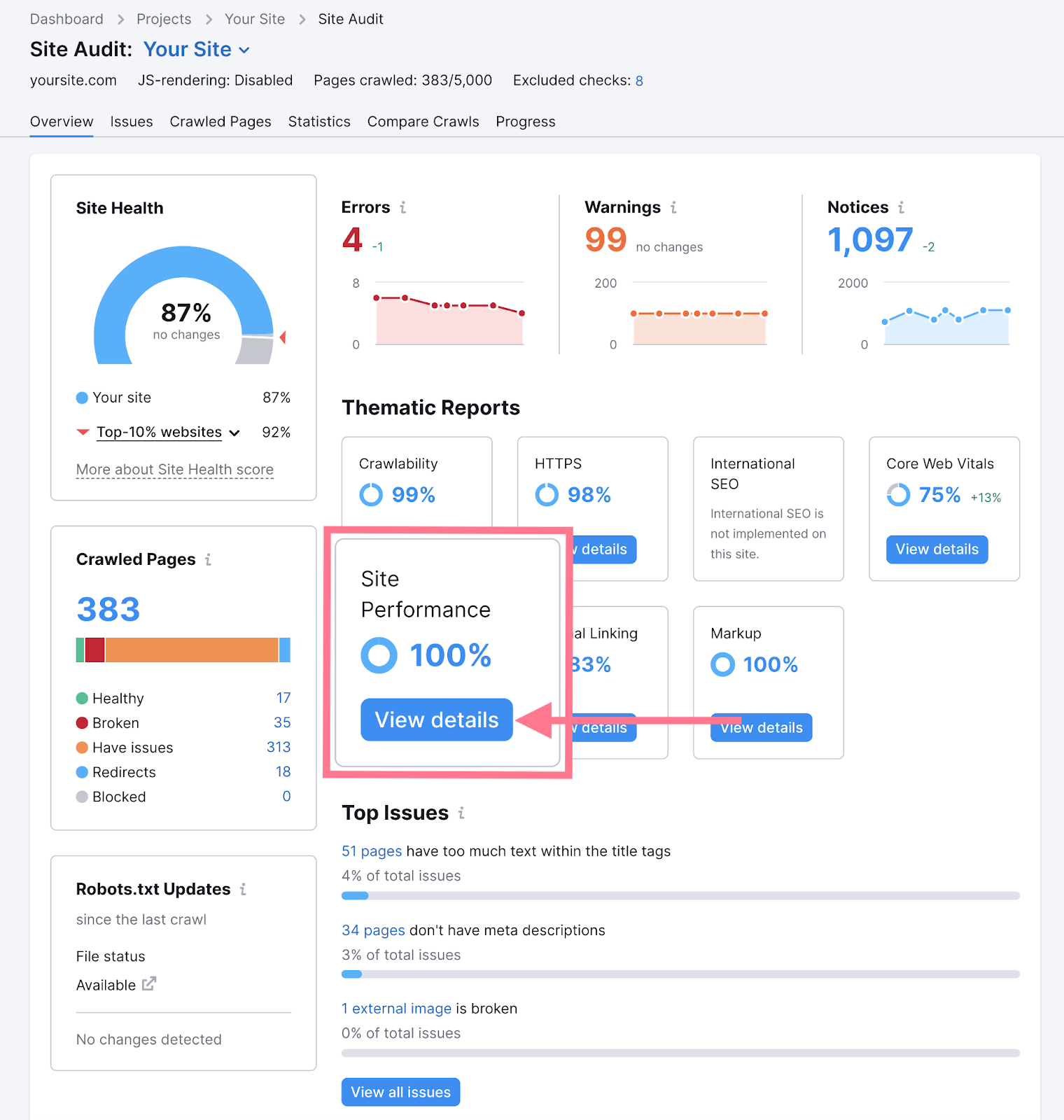
Here, you’ll be able to see your website’s load speed, as well as any discovered issues.
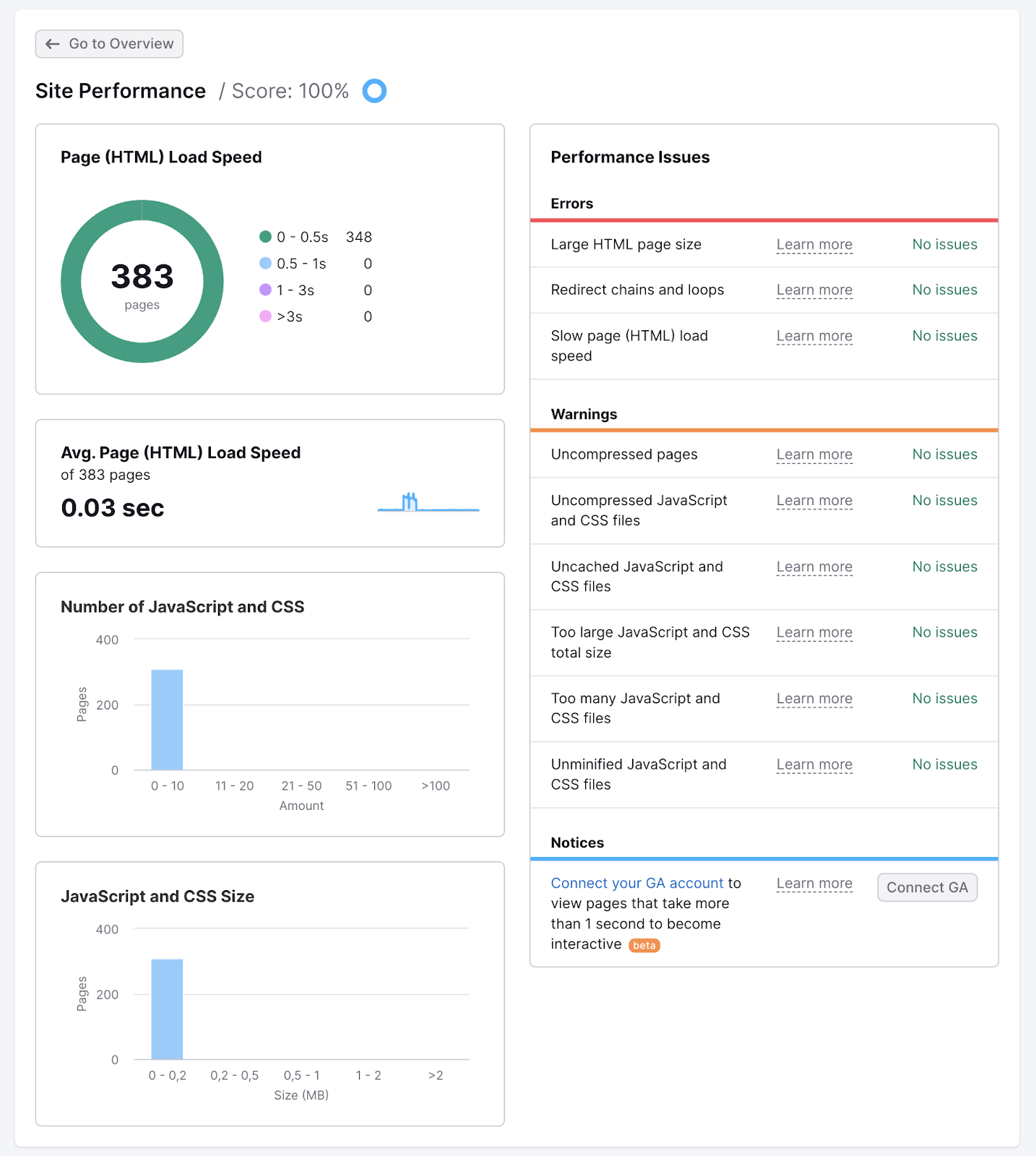
Use Accelerated Mobile Pages (AMP)
If you want to go one step further in optimizing page load speeds, you can consider implementing Accelerated Mobile Pages.
Accelerated Mobile Pages (AMP) is an HTML framework spearheaded by Google and designed to help websites load faster on mobile devices.
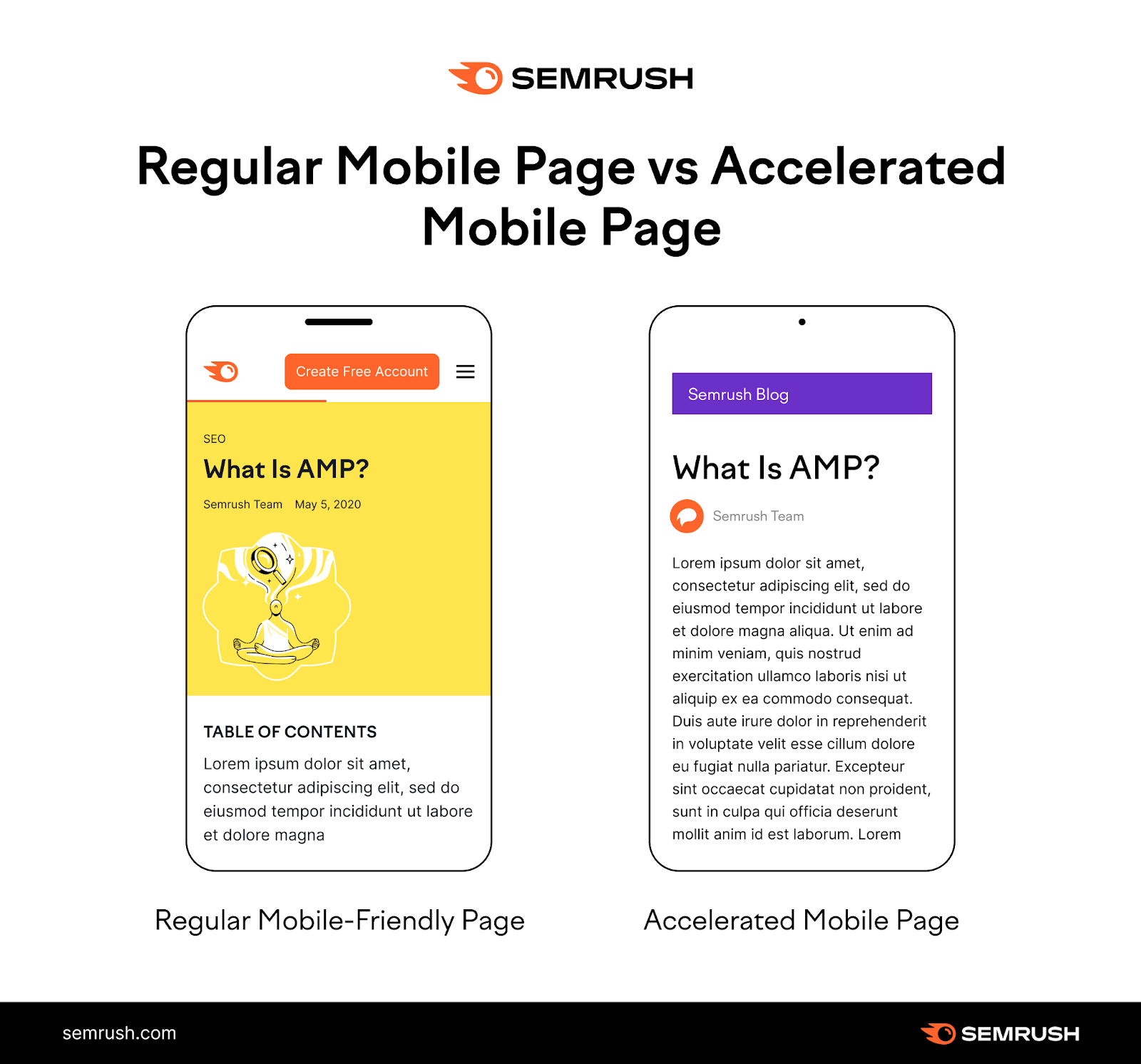
To implement AMP, you need to create AMP versions of your website pages that will exist alongside the regular ones.
The specifications for AMP are well-documented. But implementation will most likely require developmental resources and goes beyond the scope of this guide. To learn more, you can check out our comprehensive guide to AMP.
Once you implement AMP, you can check the validity of your AMP pages with Semrush’s Site Audit tool.
Expand Your Reach with Google Discover
Google Discover can be a great way to drive more traffic to your website and get in front of your target audience for free.
Start by following our Google Discover SEO tips outlined above to optimize your content for Google Discover. And track the appearance of your pages in Google Discover by using the Discover section in Google Search Console.
Then, use Semrush’s On Page SEO Checker tool to make sure your website adheres to all of Google’s on-page SEO best practices.
